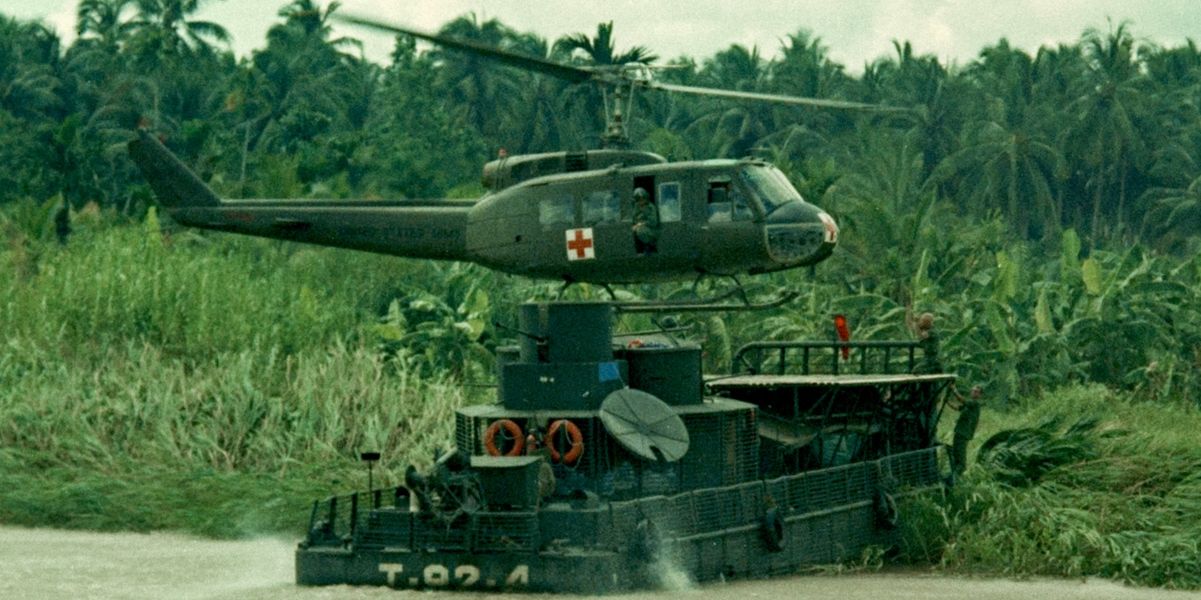The UH-1 Huey
The UH-1 “Iroquois” helicopter, also known as the “Huey” for the phonetic sound of its original designation, HU-1, served as the Army’s workhorse throughout the Vietnam War. The Army had great expectations for the helicopter’s combat effectiveness, but it took some time for the technology to reach that level of development during World War II. Early helicopter versions, such as the widely used OH-13 “Sioux” and the USAF H-19, were used for medical evacuation and resupply transports during the Korean War. These early aircraft’s combat experiences taught crucial lessons that helped create the UH-1.
The UH-1 Huey during the Vietnam War
The first Hueys were transported to Vietnam in 1958 when they were employed in “dustoff” medical evacuation (medevac) operations by US advisors. The Army incorporated the helicopter into its broader operations during the Vietnam War, extending the platform’s role beyond medevac. Because of its reputation for “doing anything a horse could do,” the Huey went from being a means for moving troops and supplies to providing direct support for combat guns.
The beloved Huey was called Slick or Dustoff. What were the differences between a Slick and a Dustoff?
The UH-1 Slick
A Vietnam vet and former UH-1 Huey crew member explains on Quora;
‘Slicks were primarily used for transporting troops, supplies, cargo, VIPs, maintenance material missions, etc. Slicks were typically armed with two M60 machine guns, one on each side. The left gun was manned by the crew chief who also prepped the ship. The right gun was manned by an enlisted man we typically called “the gunner.” He was responsible for cleaning and maintaining the M60, a daily job.
‘The M60’s on a slick were primarily for defensive purposes. You would not typically use a slick for attacking enemy positions. If a slick got in trouble with the enemy, the best thing to do was to back off, shoot your way out if you have to, then call in the gunships.’
The UH-1 Dustoff

‘Dustoffs were primarily used for med-evacs and carried the requisite medical gear to treat wounded in flight. The crew in the back often were just the crew chief and a medic or two. They also often had a red cross on the nose. Via Geneva Convention, dust-offs were not allowed to carry armament, which in theory, would insulate them from enemy fire. Of course, most VC had never heard of the Geneva Convention and dust offs frequently took fire. The red cross on the nose was a perfect aiming point. Since the crew had no way to return fire, the dust-off mission was one of the hairiest in VN.
‘So that’s the difference between slicks and dustoffs. The helo’s were the same but the armament, crews and the missions were different. However, if there were wounded on the ground that needed evacuation and there was no dust-off available, a nearby slick would be called upon to medevac the casualties out. This happened to me.’
Slick called to evac seven Army of Vietnam soldiers from a hot Landing Zone
‘My slick was called to evac seven Army of Vietnam soldiers from a hot Landing Zone. The gunner on the right suppressed the enemy while I loaded the ARVNs [Army of the Republic of Vietnam] through the left doorway. All were dead. The KIA’s buddies were in a huge hurry as we were under fire, so they simply tossed the KIA’s into the cabin. We got out of there in a hurry with a pile of seven limp, shredded, burned, bleeding, broken, leaking ARVNs and the swirling air current in the cabin distributed their remnants and bodily fluids throughout the helo’s interior. And on me. We dropped them off at a Vietnamese mortuary, then flew home. That night, I scrubbed and scrubbed the cabin floor but could not get the stench out. The bodily fluids had seeped through the gaps in the floor boards and down into the belly.’
Great difficulty prepping raw meat for a meal
He concludes;
‘To this day, I remember the smell of freshly cut and shredded flesh. The only time I had a flashback after VN was when I had to visit a slaughter house to gather 5 gallons of bovine blood for testing a medical device. The smell was overwhelming and I had to get out. Butcher’s businesses had the same effect on me. Awful. It’s also the reason I have great difficulty prepping raw meat for a meal. Thank God my wife does not mind.’

Photo by U.S. Army

